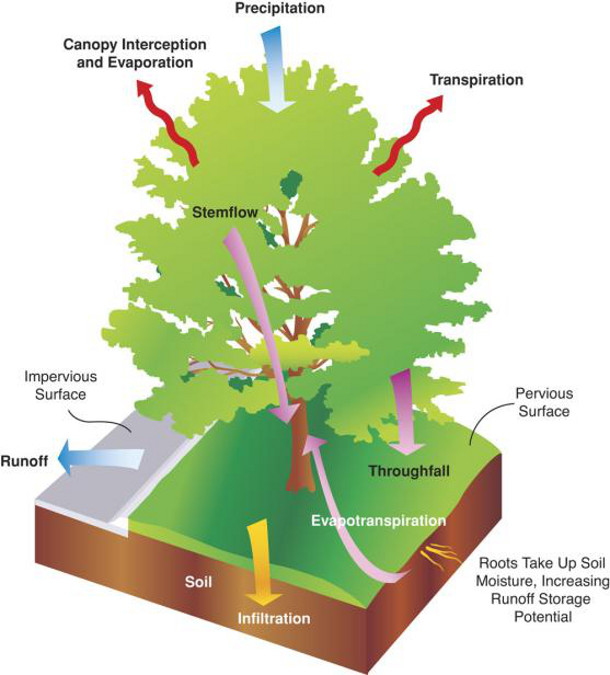
Xiao, Q.; McPherson, E.G.; Ustin, S.L.; Grismer, M.E. 2000. A new approach to modeling tree rainfall interception. Journal of Geographical Research Atmospheres 105: 29173-29188.
Need a lively discussion topic for the dinner table, a road trip, or a hot date? How about stormwater credits for trees?! A group of us started discussing the intricacies of how to set up a stormwater credit system for trees two summers ago, only to discover that the subject was even more “interesting” (both in the true sense and the Minnesotan sense of the word!) than we had anticipated.
As discussed in earlier blogs, trees provide stormwater benefits through the following mechanisms:
- Interception
- Soil storage
- Evapotranspiration
- Pollutant reduction through soil adsorption and biological processes
One of the main factors that makes tree stormwater credits harder to quantify than most other best management practices (BMPs) is that the benefits trees provide increase so dramatically as the tree grows. For example, a healthy 40 year old Hackberry tree in the Midwest is estimated to provide 14 times as much interception as a 10 year old Hackberry (McPherson et al 2006). So should the tree get more credit as it ages? How do you reconcile that with the fact that the regulatory requirements you have to meet are the same every year? How would you enforce and track changing credits?
This naturally leads to the question of whether a tree should get the same credit every year? Should you just average the benefits it will get over its lifetime? If so, how do you ensure you get enough stormwater treatment during the years the tree does not yet provide that average level of benefits to justify that calculation?
Not only do tree benefits vary with tree size, they also vary with tree architecture, species, climate, season, proximity to impervious surface, storm intensity, frequency, duration, etc. Given that, does it make more sense to take a step back and base credits on the urban forest as a whole rather than per individual tree, and to set minimum size distribution and species standards for the forest as a whole? And how do we incentivize preserving large existing trees rather than just replacing them with small ones whenever possible? In all cases, who is responsible for the trees?
The real question I am getting at is: is it possible to pull all these variables into a crediting system that is not too complicated to work, but still does not significantly over- or under- credit the stormwater benefits of trees?
It’s not a black and white question and we probably won’t come up with a “yes” or “no” answer immediately. We need to do the best we can with the science we have. Not giving trees any stormwater credit because it’s too complicated to figure out is not a good solution either. We know that trees provide significant stormwater benefits (as well as many other benefits), so we want to give them credit for the stormwater services they provide.
This blog is the first in a series about stormwater credits for trees. In the next blog, I will look at specific examples of how stormwater credits for trees are being handled in cities that have already developed their own.
So no, it’s not a subject I would bring up at my dinner table (though I’m sure my ten month old son would be fascinated by it) or on a date with my (awesome!) husband, BUT, we do hope to generate discussion on this topic from our blog readers. Please share your thoughts, comments, and experiences with us here or on our Facebook page!
Nathalie Shanstrom is a landscape architect with the Kestrel Design Group. She specializes in sustainable design.






Leave Your Comment